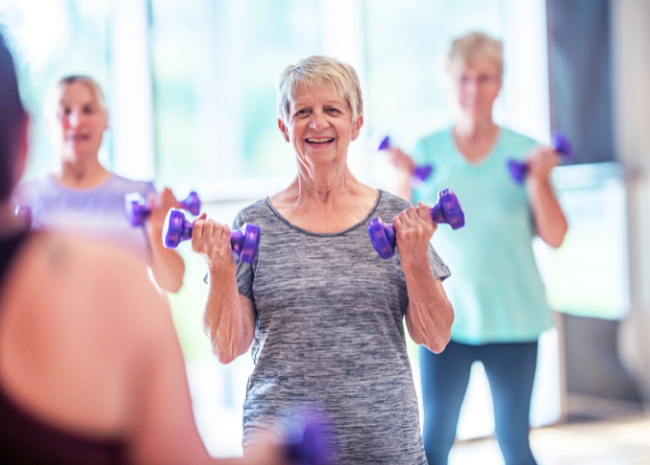
It wasn’t long ago that the only treatment for osteoporosis was taking medications along with calcium and vitamin D supplements.
Current thinking, however, suggests that weight-bearing exercises are a vital component of osteoporosis treatment.
In this comprehensive guide, we discuss the best exercises for osteoporosis and which ones are right for you.
What Are Weight-Bearing Exercises?
What does weight-bearing mean? It simply refers to any activity that requires the bones and muscles to withstand the effects of gravity (i.e., the impact of the total weight of a body), such as brisk walking, jogging, mowing the lawn or climbing stairs.
The old way of thinking restricted these activities for people with osteoporosis. Now these activities are encouraged.
Benefits of Weight-Bearing Exercises For Osteoporosis
The more weight-bearing exercise one does, the more the bones must adapt to the impact and pull of muscles by building more cells and becoming stronger. If you limit the body’s ability to strengthen itself, you are overlooking a key element of treatment.
Weight-bearing exercises:
- Strengthen Bones: Weight-bearing activities stimulate bone formation and increase bone density, making bones stronger and less susceptible to fractures.
- Improve Muscle Strength: These exercises help strengthen the muscles around bones, providing better support and reducing the risk of falls.
- Enhance Balance and Coordination: Regular weight-bearing exercises improve balance and coordination, which can prevent falls and related fractures.
- Promote Joint Health: Weight-bearing activities help maintain joint flexibility and reduce stiffness, supporting overall joint health.
- Boost Overall Fitness: Engaging in weight-bearing exercises improves cardiovascular fitness, stamina, and endurance, promoting better overall health.
- Manage Weight: Regular physical activity, including weight-bearing exercises, can help manage weight and reduce the risk of obesity, which is a risk factor for osteoporosis.
- Enhance Mood and Mental Well-being: Exercise releases endorphins that can improve mood and reduce feelings of anxiety or depression often associated with chronic conditions like osteoporosis.
- Maintain Independence: By improving strength, balance, and overall fitness, weight-bearing exercises help individuals maintain independence in daily activities.
- Support Bone Remodeling: These exercises stimulate bone remodeling processes, where old bone tissue is replaced with new bone tissue, contributing to bone health maintenance.
- Reduce Risk of Other Chronic Conditions: Regular exercise is associated with lower risk of various chronic conditions such as cardiovascular disease, diabetes, and certain cancers, which can indirectly benefit bone health.
Best Exercises For Osteoporosis
For overall bone health, exercises like brisk walking, jogging, dancing, and stair climbing are highly recommended. These activities force the bones to bear weight, stimulating bone growth and strength.
Low-Impact Aerobics and Machines
Performing aerobics, using an elliptical or stair-step machine, or walking at a brisk pace can build up your strength and allow you to move to more moderate-impact routines.
While yoga, Pilates, and tai chi have also become popular low-impact programs that build your strength and endurance, some techniques are difficult and not suggested for individuals fighting the effects of osteoporosis.
Strength Training
In addition to those weight-bearing exercises, strength training is essential to better cope with the impacts of gravity. Examples include the use of elastic bands, weights, and your own body weight.
Exercises for the Spine
- Back extensions: Perform gentle back extensions while lying face down or standing with hands on hips, slowly lifting the chest off the ground or arching the back.
- Abdominal strengthening: Engage in exercises that strengthen the abdominal muscles, such as planks, pelvic tilts, and modified crunches. These exercises support the spine and improve core stability.
- Yoga poses: Incorporate yoga poses that promote spinal flexibility and strength, such as cat-cow stretch, Cobra pose (Bhujangasana), and Bridge pose (Setu Bandhasana). These poses help elongate the spine and improve posture.
- Pelvic tilts: Lie on your back with knees bent and gently tilt your pelvis upward, engaging your abdominal muscles to flatten the lower back against the floor. Hold for a few seconds and release.
- Wall angels: Stand with your back against a wall, arms bent at 90 degrees with elbows and wrists against the wall. Slowly slide your arms up and down the wall, maintaining contact with the wall throughout the movement.
These help improve posture and spinal strength, crucial for those with osteoporosis.
Exercises for the Hips
Strong hips are essential for stability and balance, reducing the risk of falls and fractures in individuals with osteoporosis. Exercises that target the hips also improve mobility and functional movement.
- Side Leg Raises: While lying on your side, lift the top leg upward without rotating the hip. Lower it back down slowly. Repeat on both sides to strengthen the hip abductors.
- Hip Abduction Exercises: Use resistance bands around the ankles while standing and slowly lift one leg sideways against the band’s resistance. Alternate legs and repeat.
- Seated Leg Lifts: Sit in a sturdy chair with feet flat on the floor. Lift one leg straight out in front of you and hold briefly before lowering it back down. Repeat with the other leg.
- Hip Flexor Stretch: Stand with one foot forward and one foot back in a lunge position. Gently push your hips forward while keeping your back straight to stretch the hip flexors.
- Squats: Perform squats with proper form to strengthen the quadriceps, hamstrings, and gluteal muscles, which support the hips. Use a chair for support if needed.
These exercises improve stability and reduce the risk of falls, common in individuals with osteoporosis.
Exercises for Seniors
Seniors with osteoporosis benefit greatly from exercises that improve strength, balance, and flexibility while minimizing the risk of falls and fractures
Gentle, low-impact activities are ideal to maintain mobility and independence.
- Walking: Engage in brisk walking regularly to promote cardiovascular health and strengthen leg muscles. Use supportive footwear and consider walking on even surfaces to reduce fall risks.
- Water Aerobics: Participate in water aerobics classes or exercises in a pool. Water provides resistance while reducing the impact on joints, making it safer for seniors with osteoporosis.
- Tai Chi: Practice tai chi for its gentle, flowing movements that improve balance, coordination, and flexibility. Tai chi also promotes relaxation and mental well-being.
- Gentle Yoga: Attend yoga classes designed for seniors or those with osteoporosis. Focus on poses that improve posture, flexibility, and core strength while avoiding high-impact movements.
- Strength Training: Use light weights or resistance bands under supervision to strengthen muscles. Focus on exercises that target major muscle groups, such as seated rows, leg presses, and bicep curls.
By incorporating these exercises into a regular routine, seniors can enhance their overall physical health, reduce the risk of fractures, and maintain independence in daily activities.
Osteoporosis Exercises to Avoid
When managing osteoporosis, it’s crucial to be mindful of exercises that could potentially increase the risk of fractures. While staying active is important, certain activities might put too much stress on fragile bones.
Here are some exercises to approach with caution:
- High-Impact Activities: Activities like running, jumping, or high-impact aerobics can jar the bones and increase the risk of fractures, especially in individuals with low bone density. Instead, opt for low-impact alternatives like brisk walking or swimming to get your heart pumping without the impact.
- Twisting or Bending Forward at the Waist: Movements that involve excessive twisting or bending forward at the waist, such as full sit-ups, toe touches, or twisting yoga poses like the full spinal twist, can strain the spine and increase the risk of compression fractures. Modify these exercises to avoid putting undue stress on your spine.
- Heavy Lifting: While strength training is beneficial for bone health, lifting heavy weights or objects improperly can strain your muscles and bones. Use lighter weights and focus on proper form to build strength safely.
- Activities with Risk of Falling: Avoid activities that increase the risk of falls, such as skiing, ice skating, or activities on uneven surfaces. Falls can lead to fractures, so prioritize exercises in safe environments with good lighting and stable flooring.
- Excessive Flexibility Exercises: While maintaining flexibility is important, avoid overstretching or extreme joint movements, especially in the spine and hips. Gentle stretching that focuses on maintaining range of motion without overextending is best.
Remember, the goal is to stay active and strengthen your bones and muscles safely. If you’re unsure about an exercise or activity, consult with a healthcare provider or physical therapist who can provide guidance tailored to your specific needs and condition.
By choosing exercises wisely, you can protect your bones and maintain your overall health and well-being.
Designing a Physical Therapy Program
We can design a physical therapy program that utilizes weight-bearing exercises useful for treating osteoporosis.
Through low-impact, controlled exercise, the goal will be to strengthen muscles around the bones and increase endurance during daily activities.
Did you know you have Direct Access* to Physical Therapy? No referral, no problem!
If you have been diagnosed with osteoporosis, make an appointment to see us. With our knowledge of body mechanics and strength training, we can be a vital part of your path to better living.
















